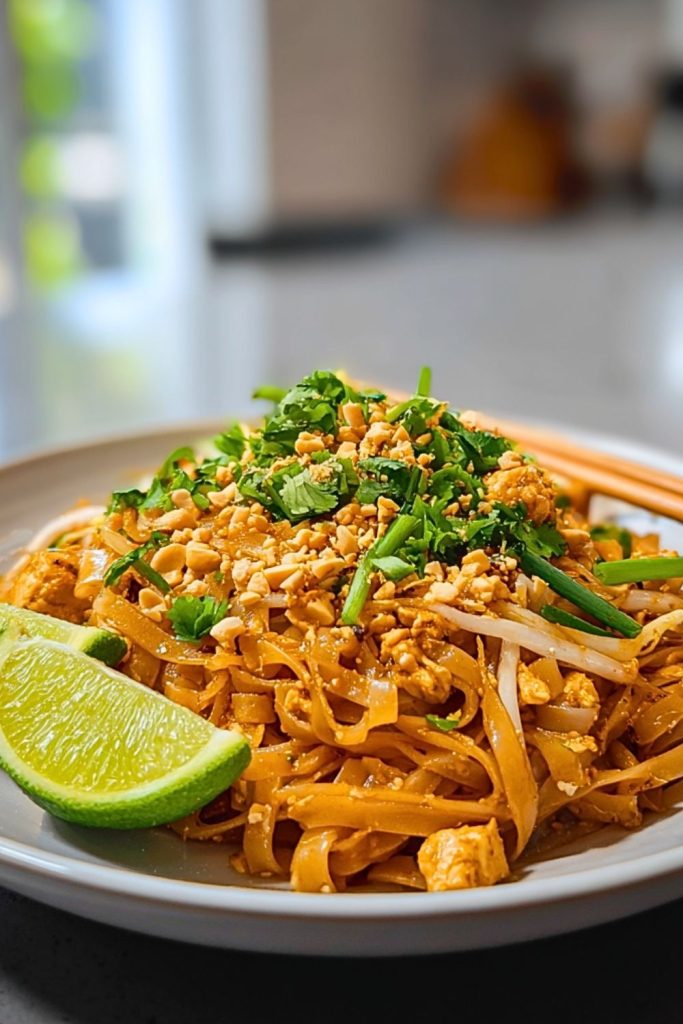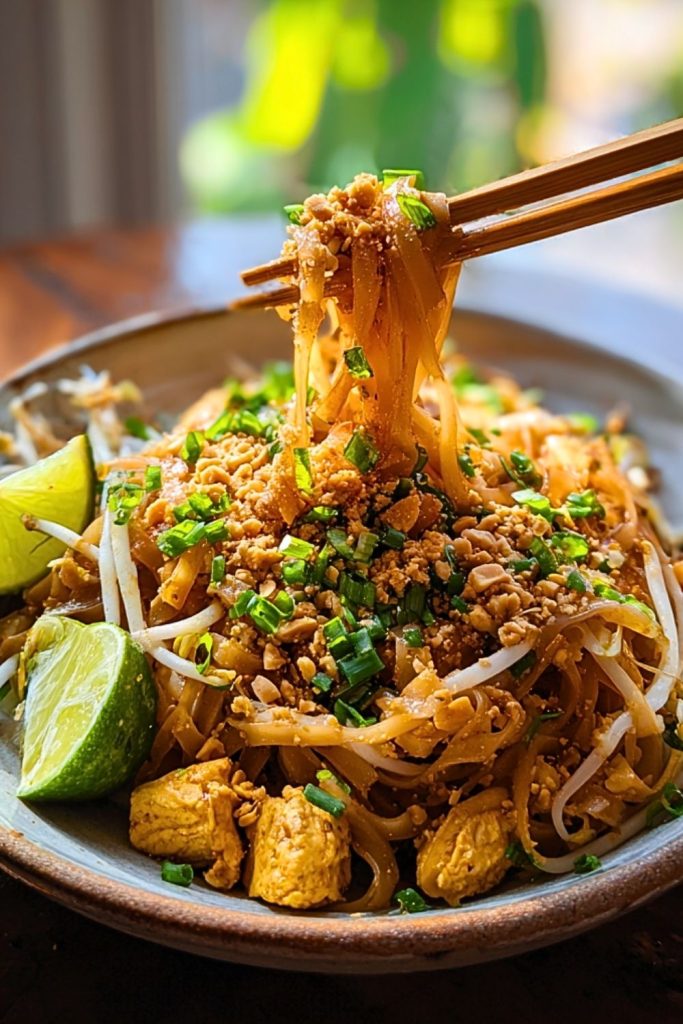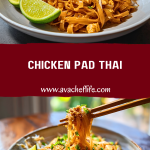Few dishes achieve the perfect harmony of flavors quite like Chicken Pad Thai. This Thai street food classic brings together chewy rice noodles, tender chicken, crunchy peanuts, fresh green onions, and a tangy-savory-sweet sauce with a bright touch of lime. It’s an irresistible medley of textures and bold tastes that feels both indulgent and comforting.

Whether you’ve enjoyed Pad Thai at your favorite Thai restaurant or are trying it at home for the first time, this dish is a winner. It’s fast to make, deeply satisfying, and surprisingly easy to customize for dietary preferences. Once you master this homemade version, takeout may never be your first choice again.
Why You’ll Love This Chicken Pad Thai
- Quick & Easy: Ready in under 30 minutes, it’s perfect for busy weeknights.
- Balanced Flavors: Sweet, salty, tangy, and spicy — the sauce hits every note.
- Customizable: Easily swap the chicken for tofu or shrimp, and adjust spice levels to taste.
- Authentic Touch: Toasted peanuts, fresh lime, and traditional fish sauce deliver real Thai essence.
- Meal Prep Friendly: Makes great leftovers and reheats beautifully.
Preparation Phase & Tools to Use (Essential Tools and Equipment, and the Importance of Each Tool)
Creating an authentic Chicken Pad Thai at home doesn’t require a professional kitchen — just a few reliable tools to get the job done right:
- Wok or Large Nonstick Skillet: A wok is ideal for high-heat cooking and tossing noodles evenly with sauce and ingredients. If unavailable, a large nonstick skillet works well too.
- Medium Saucepan: Needed to soak or parboil rice noodles to the perfect chewy texture.
- Sharp Knife and Cutting Board: For prepping chicken, garlic, scallions, and garnishes.
- Tongs or Silicone Spatula: These help turn and toss ingredients without breaking the noodles.
- Mixing Bowl: Handy for whisking together the Pad Thai sauce before adding it to the wok.
Each of these tools plays a role in ensuring efficiency, flavor balance, and the signature texture that makes Pad Thai shine.
Preparation Tips
- Soak the Noodles Properly: Don’t overcook the rice noodles. Soak them in hot water until just pliable, then let them finish cooking in the wok with the sauce.
- Mise en Place: Pad Thai cooks quickly, so have everything chopped, mixed, and within arm’s reach before heating the pan.
- Use High Heat: A hot wok helps caramelize ingredients and prevents sogginess.
- Balance the Sauce: Taste and adjust the sauce before adding it to the wok — a touch more sugar, tamarind, or fish sauce can make all the difference.
- Avoid Overcrowding: Cook in batches if necessary to keep ingredients from steaming instead of stir-frying.
Ingredients for This Chicken Pad Thai
Here’s what you’ll need to make a delicious, restaurant-quality Chicken Pad Thai at home:
For the Sauce:
- 3 tablespoons fish sauce
- 1 tablespoon soy sauce
- 2 tablespoons tamarind paste
- 1 tablespoon brown sugar
- 1 tablespoon lime juice
- 1–2 teaspoons Sriracha or Thai chili sauce (adjust to taste)
For the Noodles and Protein:
- 8 oz flat rice noodles
- 1 lb boneless, skinless chicken breast or thighs (thinly sliced)
- 2 tablespoons vegetable oil (divided)
- 2 eggs, lightly beaten
Vegetables and Garnishes:
- 3 cloves garlic, minced
- 1 cup bean sprouts
- 3 green onions, sliced
- 1/4 cup chopped roasted peanuts
- 1/2 cup fresh cilantro or Thai basil (optional)
- Lime wedges, for serving
These ingredients form the heart of the dish — bold, flavorful, and deeply satisfying. Feel free to adjust spice and sweetness levels to match your preferences.

Step 1: Soak the Rice Noodles
Place the rice noodles in a large bowl and cover them with very hot (but not boiling) water. Let them soak for 6–8 minutes, or until tender but still slightly firm. Drain and set aside.
Step 2: Prepare the Sauce
In a small mixing bowl, combine fish sauce, soy sauce, tamarind paste, brown sugar, lime juice, and Sriracha. Stir until the sugar dissolves. Set aside for later.
Step 3: Cook the Chicken
Heat 1 tablespoon of oil in a wok or large skillet over medium-high heat. Add the sliced chicken and cook for 4–5 minutes until lightly browned and cooked through. Remove chicken and set aside.
Step 4: Scramble the Eggs
Add the remaining tablespoon of oil to the wok. Pour in the beaten eggs and scramble them gently until just set. Push to one side of the pan.
Step 5: Stir-Fry with Aromatics
Add garlic to the pan and sauté for 30 seconds until fragrant. Return the chicken to the wok and add the drained noodles. Toss everything together.
Step 6: Add the Sauce and Toss
Pour the prepared Pad Thai sauce over the noodles and toss well to coat evenly. Cook for 1–2 minutes, allowing the sauce to absorb and caramelize slightly.
Step 7: Finish with Veggies and Garnishes
Stir in bean sprouts and green onions. Cook for another minute. Remove from heat and top with chopped peanuts, fresh herbs if using, and a generous squeeze of lime.
Step 8: Serve
Plate the Chicken Pad Thai immediately while hot, and garnish with additional lime wedges and peanuts for extra flavor and crunch.
Notes
- Tamarind Paste Substitute: If you can’t find tamarind paste, you can use a mix of lime juice and a little rice vinegar as a substitute. It won’t be quite the same, but it will still bring tanginess.
- Protein Options: While chicken is classic, shrimp, tofu, or even thinly sliced beef can be used in this recipe.
- Make it Vegetarian: Skip the fish sauce and substitute with soy sauce or tamari. Add tofu or more vegetables like bell peppers or snap peas.
- Noodle Texture: Be cautious not to oversoak or overcook the noodles; they should be firm enough to hold their shape when stir-fried.
- Spice Level: This dish is easily adjustable — increase or decrease Sriracha to suit your taste.
Watch Out for These Mistakes While Cooking
- Skipping Prep: This dish moves fast. If ingredients aren’t ready before you start, it can quickly turn chaotic.
- Overcooking Noodles: Rice noodles continue to cook in the pan, so undercook slightly during soaking.
- Cold Wok or Pan: A hot pan ensures proper stir-fry texture — starting cold can make ingredients soggy.
- Too Much Sauce at Once: Adding too much sauce can make the dish wet or too salty. Start with less and adjust.
- Not Tossing Quickly: Stir constantly once the sauce is added to evenly distribute flavor and prevent sticking.
- Crowded Pan: Overcrowding cools the pan and causes steaming. Cook in batches if necessary.
- Burning Garlic: Garlic cooks fast. Add it only after eggs are scrambled to avoid bitterness.
- Using Regular Pasta: Rice noodles are essential for authenticity — spaghetti won’t give the right texture or flavor.
What to Serve With Chicken Pad Thai?
While Chicken Pad Thai is a complete and flavorful meal on its own, pairing it with the right sides can enhance the dining experience and bring variety to the table.
8 Recommendations
- Thai Cucumber Salad
A cool, crisp contrast to the warm noodles, this salad with vinegar, sugar, and chili offers refreshing acidity. - Tom Yum Soup
This hot and sour Thai soup adds a zesty, aromatic note to your meal. - Spring Rolls (Fresh or Fried)
Filled with vegetables or shrimp, they make a perfect appetizer or crunchy side dish. - Thai Iced Tea
Sweet, creamy, and spiced — this iconic drink balances Pad Thai’s savory elements beautifully. - Papaya Salad (Som Tam)
Tangy, spicy, and slightly sweet, it adds bright flavors and a crunchy texture to the table. - Steamed or Stir-Fried Vegetables
A simple veggie medley with garlic and soy sauce rounds out the meal with a nutritious side. - Satay Skewers
Grilled chicken or beef skewers served with peanut sauce are an irresistible addition. - Mango Sticky Rice
If you’re finishing with dessert, this Thai classic made with coconut milk and ripe mango is a satisfying endnote.
Storage Instructions
Chicken Pad Thai stores surprisingly well and can make for a delicious leftover meal:
- Refrigerate: Transfer cooled leftovers to an airtight container. Store in the fridge for up to 3 days.
- Reheat: Warm in a skillet over medium heat with a splash of water or oil to loosen the noodles. Microwave reheating is also possible, but stir halfway to avoid uneven heating.
- Freezing: Not recommended. The texture of rice noodles tends to become mushy after thawing.
To maintain freshness and flavor, always store garnishes (like peanuts and lime wedges) separately and add them just before serving.
Estimated Nutrition (Per Serving – Approx. 4 Servings)
- Calories: 480–520
- Protein: 32g
- Carbohydrates: 52g
- Fat: 18g
- Fiber: 3g
- Sugar: 8g
- Sodium: 920mg
Nutrition values will vary based on portion size, exact ingredients, and specific brands used. For lower sodium, reduce the fish sauce and soy sauce or use low-sodium versions.
Frequently Asked Questions
1. Can I make Chicken Pad Thai ahead of time?
Yes, you can prepare the sauce and chop the vegetables and chicken a day in advance. Cook everything fresh when you’re ready to eat for the best texture and flavor.
2. What’s the best substitute for tamarind paste?
A mixture of lime juice and rice vinegar with a touch of brown sugar can mimic tamarind’s tanginess in a pinch.
3. Is Pad Thai supposed to be sweet?
Pad Thai has a delicate balance of sweet, salty, sour, and spicy. It shouldn’t be overly sweet — adjust the sugar to your taste.
4. Can I use pre-cooked chicken?
Yes, shredded or sliced cooked chicken can be added at the end of the cooking process to heat through.
5. How do I prevent noodles from sticking together?
Toss the soaked noodles with a touch of oil or cook them immediately after soaking to keep them from clumping.
6. Is it gluten-free?
Use gluten-free soy sauce or tamari and ensure the fish sauce is gluten-free to make this dish suitable for gluten-sensitive diets.
7. Can I double the recipe?
Yes, but it’s best to cook in two batches to avoid overcrowding the pan and ensure even cooking.
8. What can I use instead of peanuts?
If you’re allergic or avoiding peanuts, toasted cashews, almonds, or sunflower seeds offer great crunch and flavor.
Conclusion
Chicken Pad Thai is more than just a takeout favorite — it’s a vibrant, satisfying dish you can master at home with just a few simple steps. Its balance of flavors, quick preparation, and customizable nature make it a go-to for any night of the week. Whether you’re impressing guests or craving something bold and homemade, this recipe delivers. Give it a try and discover why it’s beloved around the world.

Chicken Pad Thai
- Prep Time: 15 minutes
- Cook Time: 10 minutes
- Total Time: 25 minutes
- Yield: 4 servings
Description
A delicious and vibrant Thai noodle dish featuring tender chicken, chewy rice noodles, a zesty-sweet-savory sauce, and topped with crunchy peanuts and fresh herbs. Quick to make, deeply satisfying, and better than takeout!
Ingredients
Sauce:
- 3 tablespoons fish sauce
- 1 tablespoon soy sauce
- 2 tablespoons tamarind paste
- 1 tablespoon brown sugar
- 1 tablespoon lime juice
- 1–2 teaspoons Sriracha or Thai chili sauce
Noodles and Protein:
- 8 oz flat rice noodles
- 1 lb chicken breast or thighs, thinly sliced
- 2 tablespoons vegetable oil
- 2 eggs, lightly beaten
Vegetables and Garnishes:
- 3 cloves garlic, minced
- 1 cup bean sprouts
- 3 green onions, sliced
- 1/4 cup roasted peanuts, chopped
- 1/2 cup fresh cilantro or Thai basil (optional)
- Lime wedges
Instructions
- Soak rice noodles in hot water for 6–8 minutes, then drain.
- Mix all sauce ingredients in a bowl and set aside.
- Heat 1 tbsp oil in a wok over medium-high heat. Cook chicken until done; remove and set aside.
- Add remaining oil to the wok. Scramble the eggs until set, then push to the side.
- Add garlic, sauté briefly, then return chicken and noodles to the wok.
- Pour in the sauce and toss everything together until well coated.
- Stir in bean sprouts and green onions. Cook for 1 more minute.
- Serve topped with peanuts, herbs, and lime wedges.

